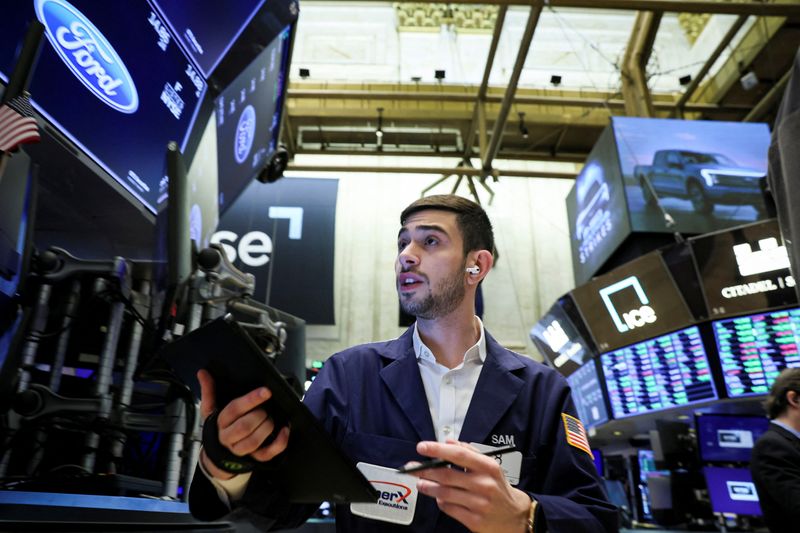By Noreen Burke
Investing.com — Equity markets were roiled last week after the Federal Reserve delivered a widely expected half percentage point rate hike and flagged similar moves at upcoming meetings as it battles to curb soaring inflation, and more volatility could be in store if Wednesday’s inflation data comes in hotter than expected. Investors will also be focusing on speeches from several Fed officials during the week. China is to release what will be closely watched data on trade and inflation, while GDP data out of the UK will likely point to slowing growth. Energy prices will also remain in focus amid a looming EU embargo on Russian oil. Here’s what you need to know to start your week.
- U.S. inflation data
Wednesday’s CPI data for April will show whether the fastest surge in inflation in over 40 years has peaked. The annual rate of inflation came in at 8.5% in March as gasoline costs hit record highs.
Economists are forecasting an annual rate of 8.1%, but a stronger than expected reading could potentially underline the case for even more aggressive monetary policy tightening from the Fed.
Investors are fearful that aggressive tightening by the Fed could tip the economy into a recession.
There will also be a flurry of speeches by Fed policymakers in the coming week, including Atlanta Fed President Raphael Bostic, New York Fed President John Williams, Fed Governor Christopher Waller, Minneapolis Fed President Neel Kashkari, Cleveland Fed President Loretta Mester and San Francisco Fed President Mary Daly.
- Elevated volatility
The Nasdaq and S&P 500 posted their fifth straight week of declines last week, and the Dow Jones Industrial Average its sixth. It was the longest losing streak for the S&P 500 since mid-2011 and for the Nasdaq since late 2012.
“The market is focused on the Fed being behind the curve and that’s why the market is down,” Keith Lerner, chief market strategist and co-chief investment officer at Truist Advisory Services told Reuters.
Markets have priced in a roughly 75% chance of a 75 basis-point rate hike at the Fed’s June meeting, despite Fed Chair Jerome Powell ruling that out last Wednesday.
Market volatility looks set to continue as the combination of a more hawkish Fed, a surge in bond yields, and geopolitical risks such as the war in Ukraine weigh on investor sentiment.
- China data
China is to release data on trade and inflation on Monday which will show the impact of Covid-19 lockdowns on the world’s second largest economy.
Economists are expecting trade data to show that export growth fell to the lowest since mid-2020 in April, while imports are expected to have contracted for a second month as domestic demand was hit by stringent lockdowns in Shanghai and elsewhere.
Inflation data is expected to show that shortages of goods drove up prices, while factory gate inflation is also expected to remain at elevated levels.
Shanghai is facing challenges getting factories, many of them key links in global supply chains, back up to speed even as much of the city of 25 million remains locked down.
- Eurozone, U.K. data
The latest data on Germany’s ZEW sentiment index and preliminary first quarter GDP data from the U.K. will highlight the dilemma central banks are facing as they try to combat soaring prices amid heightened concerns over the outlook for growth.
Economists are expecting the ZEW index to have dropped again in April from a level that was already the lowest since the beginning of the pandemic in 2020.
In the U.K., the economy is expected to have expanded by 1% in the first quarter, but the monthly reading for March is expected to be flat.
Last week the Bank of England warned that Britain risks a double-whammy of a recession and inflation above 10% as it hiked interest rates to 1%, their highest since 2009.
Several European Central Bank officials are due to speak during the coming week, including President Christine Lagarde on Wednesday.
- Energy prices
The European Union is close to agreeing on a fresh round of sanctions against Moscow for invading Ukraine, including a phased embargo on Russian oil, which makes up over a quarter of EU imports.
The move will push European refineries into a race to find new crude suppliers and leave drivers with bigger bills at the pump at a time when the cost of living crisis is squeezing consumers globally.
The looming ban saw U.S. crude prices rise about 5% for the week last week, while Brent rose almost 4% as the prospect of tighter supply offset concerns over the outlook for the global economy.
“In the near term, the fundamentals for oil are bullish and it is only fears of an economic slowdown in the future that is holding us back,” Phil Flynn, an analyst at Price Futures Group told Reuters.
–Reuters contributed to this report


